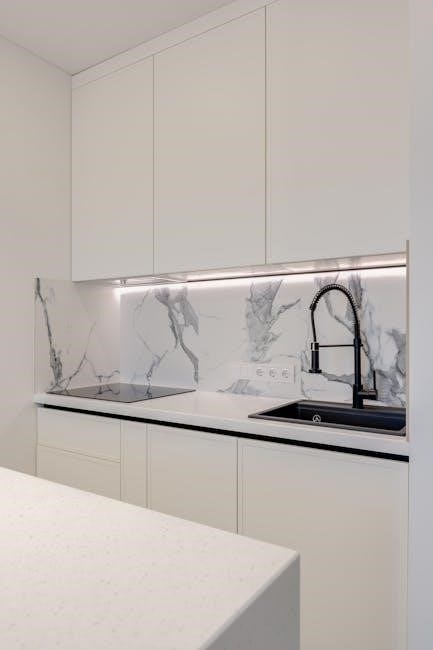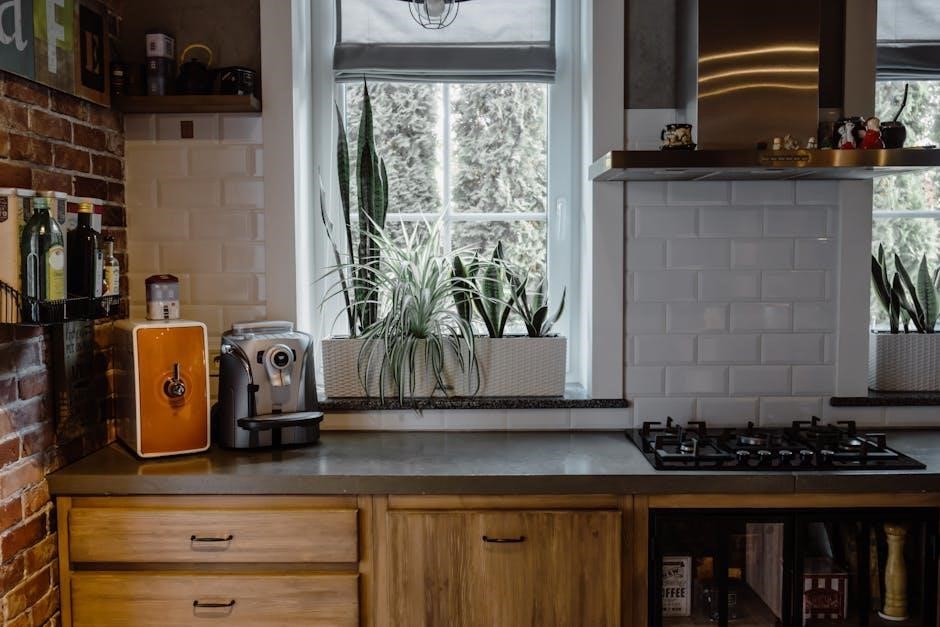To begin, cabinet knob placement guide involves considering door style and size, using
standard guidelines
for optimal functionality and aesthetic appeal, ensuring a beautiful and functional space always․
Importance of Proper Placement
Proper cabinet knob placement is crucial for both functional and aesthetic reasons, as it can greatly impact the overall look and feel of a room․ The placement of cabinet knobs can affect the ease of use and accessibility of the cabinets, making it essential to consider the needs of the users․ A well-placed cabinet knob can make a significant difference in the usability of the cabinet, while a poorly placed one can lead to frustration and discomfort․ Furthermore, proper placement can also enhance the visual appeal of the cabinets, creating a sense of harmony and balance in the room․ By considering the importance of proper placement, individuals can ensure that their cabinets are not only functional but also visually appealing, creating a cohesive and inviting space․ This is particularly important in kitchens and bathrooms where cabinets are frequently used, and proper placement can make a significant difference in the overall user experience․

Standard Practices for Cabinet Knob Placement
Standard practices involve installing knobs on the stile opposite hinges, using specific measurements for optimal results always․
Knob Placement on Doors
To ensure proper knob placement on doors, it is essential to consider the door’s style and size, as well as the type of knob being used․ The general rule is to place a knob 2 1/2 to 3 inches from the corner of the door, on the stile opposite the hinges․ This placement allows for easy access and provides a visually appealing look․ Using a template or measuring carefully can help achieve accurate placement; Additionally, the door’s hardware, such as handles or pulls, should be considered when determining knob placement․ By following these guidelines, homeowners can create a beautiful and functional space that meets their needs and complements their decor․ With the right knob placement, doors can be easily opened and closed, and the overall look of the room can be enhanced․ Proper knob placement is a crucial aspect of cabinet design and can make a significant difference in the overall appearance of a room․
Guidelines for Upper Cabinets
Upper cabinets require careful planning, as
placement
affects accessibility and visual appeal, ensuring a functional space always with proper installation․
Corner Placement for Upper Cabinets
When it comes to corner placement for upper cabinets, there are several factors to consider, including the size and style of the cabinet, as well as the overall aesthetic of the room․
The placement of knobs or handles in the corner of an upper cabinet can greatly impact the functionality and accessibility of the space․
In general, it is recommended to place the knob or handle in the bottom corner of the upper cabinet door, as this allows for easy opening and closing․
This placement also helps to create a sense of balance and harmony in the room, which is especially important in smaller spaces․
Additionally, considering the diameter and style of the cabinet knobs can also play a role in determining the optimal corner placement․
By taking the time to carefully plan and consider the corner placement of upper cabinets, homeowners can create a beautiful and functional space that meets their needs and enhances their quality of life;
Using the right hardware and placement can make a big difference in the overall look and feel of the room․
Proper corner placement is essential for a well-designed and functional space․

Types of Cabinet Knobs and Pulls
Various cabinet knobs and pulls are available, including modern and traditional styles, offering flexibility in design and functionality with
different materials
and finishes always․
Diameter and Style of Cabinet Knobs
Cabinet knobs come in a variety of diameters and styles, ranging from small and subtle to large and statement-making, with standard sizes between 1-2 inches in diameter, and some as large as 3 inches․
The style of the knob can greatly impact the overall look and feel of the cabinet, with options including modern, traditional, and rustic, among others․
The diameter of the knob is also important, as it can affect the ease of use and functionality of the cabinet․
A larger knob may be easier to grasp and turn, but it may also be more noticeable and potentially overwhelm the surrounding design․
On the other hand, a smaller knob may be more subtle, but it may also be more difficult to use, especially for those with limited dexterity․
Ultimately, the choice of knob diameter and style will depend on the individual’s personal preference and the overall aesthetic of the space, with consideration given to comfort, convenience, and visual appeal, making it a crucial decision in the design process, and one that requires careful consideration of various factors and options․

Placement Considerations for Different Styles
Consider the style and design of the cabinet and room when determining knob placement for optimal functionality and visual appeal always using
guidelines
and expert advice․
Functional and Aesthetic Considerations
When considering the placement of cabinet knobs, it is essential to think about both functional and aesthetic considerations․ The location of the knob can affect the overall look and feel of the cabinet, as well as its usability․ A well-placed knob can make a cabinet more accessible and convenient to use, while a poorly placed knob can be frustrating and difficult to operate․ In terms of aesthetics, the placement of the knob can also impact the visual balance and harmony of the cabinet and the surrounding space․ By taking the time to carefully consider these factors, individuals can ensure that their cabinet knobs are both functional and visually appealing, creating a positive and enjoyable user experience․ Using guidelines and expert advice, homeowners can make informed decisions about cabinet knob placement, resulting in a beautiful and functional space that meets their needs and enhances their daily lives․

Expert Advice on Cabinet Knob Placement
Experts offer valuable insights and tips on cabinet knob placement, using
guidelines
and best practices to achieve optimal results always perfectly․
Best Practices and Trends in Cabinet Hardware
When it comes to cabinet hardware, there are several best practices and trends to consider․ Many experts recommend choosing hardware that complements the style and finish of the cabinets, as well as the overall aesthetic of the room․ Some popular trends in cabinet hardware include the use of mixed metals, such as combining brass and silver tones, and the incorporation of unique and unconventional materials, such as glass or ceramic․ Additionally, many homeowners are opting for hardware with a matte or satin finish, which can add a touch of sophistication and elegance to the space․ By staying up-to-date on the latest trends and best practices in cabinet hardware, homeowners can create a beautiful and functional space that reflects their personal style․ Using online resources and consulting with design experts can also provide valuable insights and inspiration for choosing the perfect cabinet hardware․ Overall, the right cabinet hardware can make a significant impact on the overall look and feel of a room․